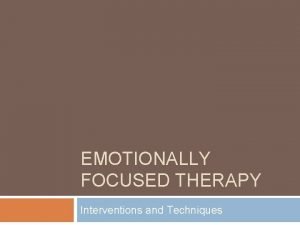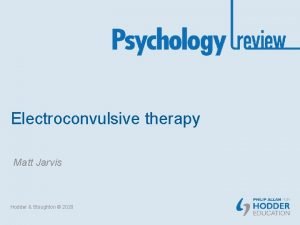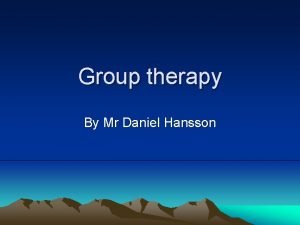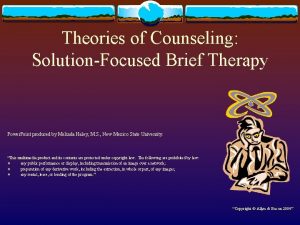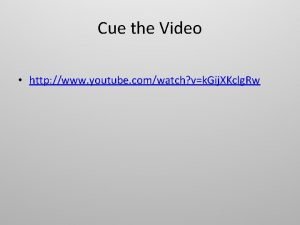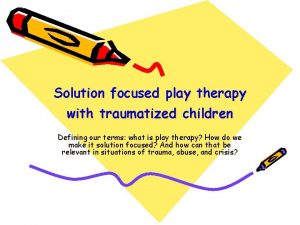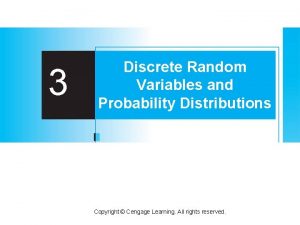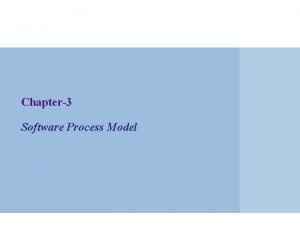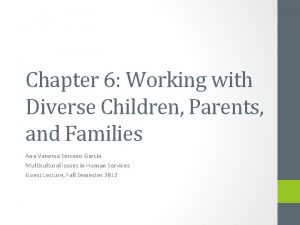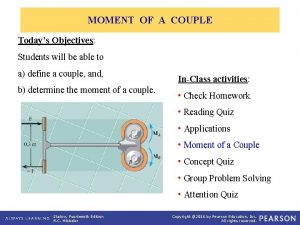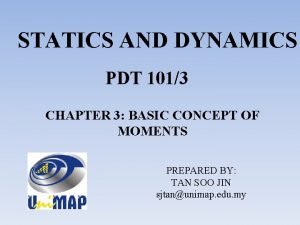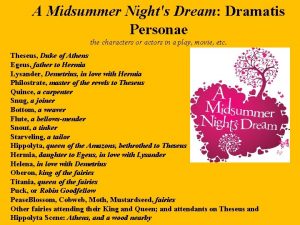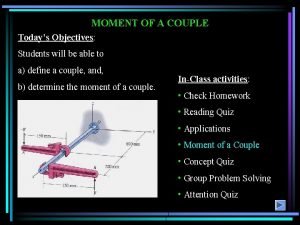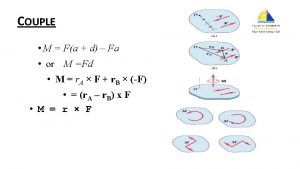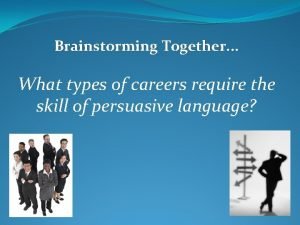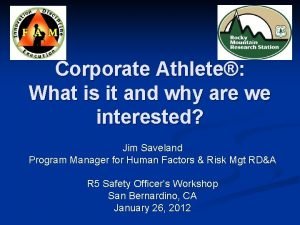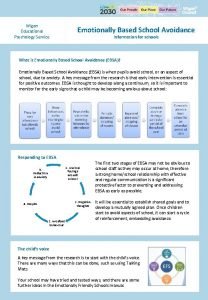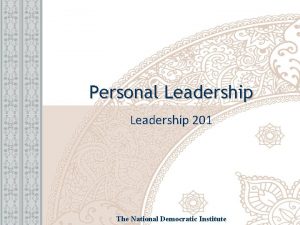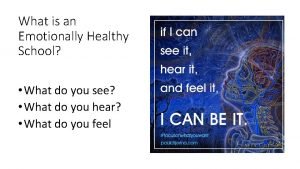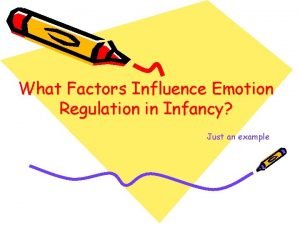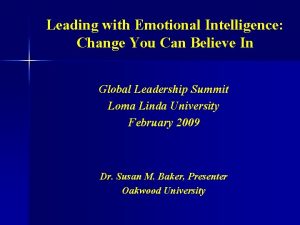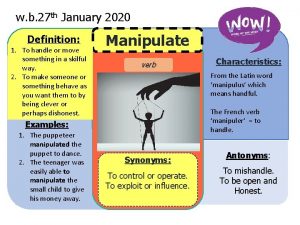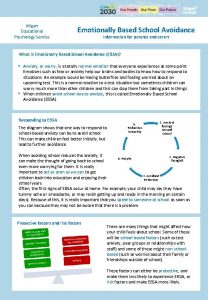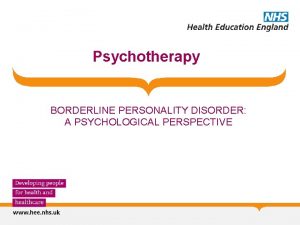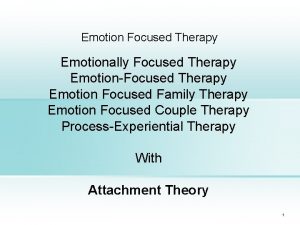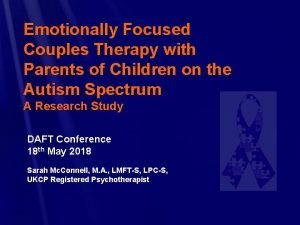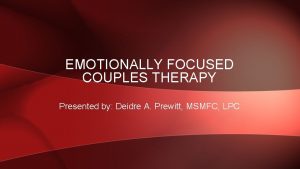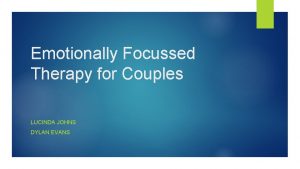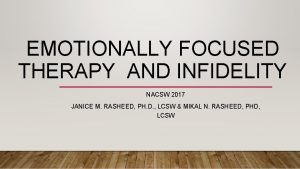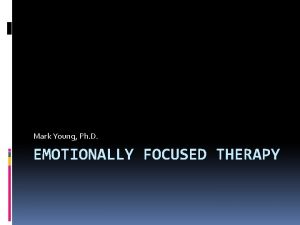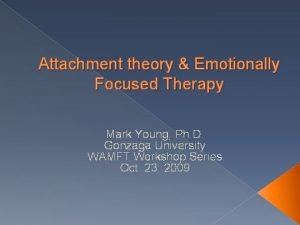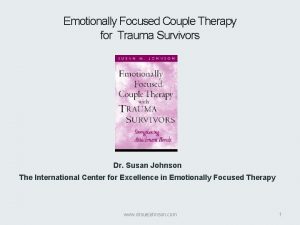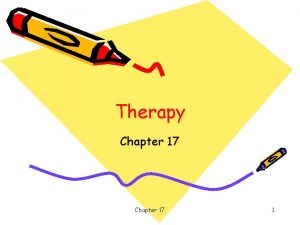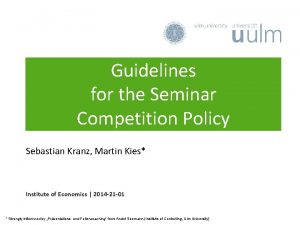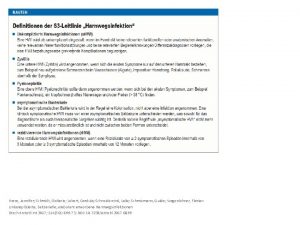Emotionally Focused Therapy for Couples Heather Kranz M


































- Slides: 34

Emotionally Focused Therapy for Couples Heather Kranz, M. S. , M. Ed.

Overview ★ Introduction to Emotionally Focused Therapy for Couples (EFT) ★ Elements of EFT ★ The “Dance” ★ Sue Johnson Video Clip ★ Stages and Interventions of EFT ★ Couples Video Clip ★ Pointers for using EFT ★ Conclusions

Emotionally Focused Therapy for Couples ★Developed by Sue Johnson and Les Greenberg in the 1980 s ★Based on Gottman’s findings regarding affect regulation ★Empirically supported, utilizes an attachment approach ★Sees problems as arising in the emotional bond between partners ★Focuses on fostering a secure emotional bond to encourage healthy levels of dependency within the relationship (Alexander, J. F. , Holtzworth-Munroe, A. , & Jameson, P. , 1994).

Elements of EFT ★Based on Adult Attachment Theory - emotional connection is the most basic motivator we have (those who are more secure are better able to regulate emotions) ★Primary emotions (e. g. , fear) are often clouded by secondary emotions (e. g. , anger) which cause distance in couples ★Focus on present process- observing couple patterns and reflect back to them what’s happening ★Uses analogy of “a dance” that mirrors the patterns in the relationship ★Goal is to create a new way of interacting that increases the emotional bond

EFT and Attachment ●Attachment Theory states that maintaining close attachment bonds is a universal human need ●Attachment style impacts how couples interact, their willingness to depend on one another in times of stress, and their level of satisfaction with the relationship ●Anxiously attached individuals are more likely to “hyper-activate” attachment needs (e. g. , neediness) out of fear they will not receive consistent support ●Avoidantly attached individuals are more likely to “de-activate” attachment needs (e. g. , withdraw) due to expectation they will not get support (Weibe et. al, 2017)

EFT and Emotions ➢ Emotions tell us what people need from us (e. g. , Crying may signal need for comfort, anger may signal keep your distance) ➢ Emotion is a basic motivating force- it pulls us to move in certain ways (e. g. , If I feel afraid I may distance myself from others and retreat to safety) ➢ Emotions organize how people interact (e. g. , If I like someone I engage in ways that promote the relationship) What has been your experience with clients who feel disconnected from their emotions?

Primary vs. Secondary Emotions When you can get people to understand their emotions and what they need- then they learn how to communicate their needs effectively To do this one needs to accurately identify the emotion they are feeling Primary: immediate, innate reaction (e. g. , sadness from loss, joy from winning lottery), tend to recede as event recedes Secondary: our emotions about our primary emotions (e. g. , feeling angry about being embarrassed, feeling shame about feeling anxious), tend to amplify over time Have you seen these types of emotions with clients?

Emotions and the Relationship ❏ Emotions play a major role in the dynamics of a relationship ❏ These dynamics are called the “dance” in EFT ❏ The “dance” refers to the patterns in relationships that are related to how couples engage with one another

EFT and the “Dance” Withdraw/withdraw- Partner A feels discouraged but instead of reaching towards Partner B for support they retreat into the bedroom. Partner B reads this as a signal that Partner A does not want to be around them and leaves for a drive. Attack/withdraw- Partner A just got laid off at work and comes home yelling at Partner B shuts down emotionally and retreats to a different room. Attack/attack- Partner A finds that Partner B failed to take out the trash for the 10 th time and yells at them. Partner B counters with complaints about Partner A’s lack of support with the children. Both partners engage in heated argument. and MANY different variations!

And You? ❖ Do any of the “dances” resonate with you? ❖ Can you identify patterns in your own relationships or the relationships of clients that might resemble a “dance”? ❖ Have these patterns been long-standing? ❖ Reactions to reflecting on your “dance”?

How does EFT work? ➔ EFT helps couples learn how to “reach” for each other, and comfort each other ➔ This is accomplished by identifying and then verbalizing primary emotions ➔ If you can create safety and connection through increasing the emotional bond, then aspects of communication and negotiation are taken care of (according to Sue Johnson)

Techniques ➔ Reflecting emotion helps organize client’s experience (“Underneath all of this anger is a fear you don’t need me”) ➔ Heighten emotional response so everyone can see it (“I feel terrified that you may no longer need me”) ➔ Asking evocative questions (“What is that like for you? ” “How are you feeling in this moment? ”) ➔ Create corrective experiences (“Can turn to your partner and tell them what you just told me? ”) Have you used any of these techniques with clients? Has it been effective?

EFT Interventions ★ Look at the “dance” and reflect the “dance” to the couple ○ “So your pattern is to experience high frustration and then express it, and your response is to withdraw? ” ★ Help clients to understand the “dance” and validate their experiences ○ “Feeling anxious can cause us to attack our partner, which causes them to shut down. Both of you are hurting from this. ” ★ Help clients to get to know and understand their own emotions ○ “You are expressing a lot of anger, but underneath you are saying ‘I am longing to feel close to you. ’”

EFT Interventions ★ Help clients to learn how to express their deeper/primary emotions ○ “When you said that to me it made me feel like you don’t value me, and I’m feeling scared that you don’t want to stay in this relationship. ” ★ Help clients to change their emotional signals and to ask for what they need ○ “When you feel angry you yell, but what you are really feeling is fear that he is pulling away. Can you share with him how this fear makes you feel? ” ★ Help clients to attune to one another and change the “dance” ○ “So the next time I pull away, it’s not because I don’t care, it’s that I’m scared I’m losing you. What I’m really needing from you in the moment is to reassure me you still love me. ”

In Session ❏ Introduce that you are trying to understand how they interact ❏ Identify the ways in which couples get “stuck” and experience difficulty in relationship ❏ Ask for feedback “If I get it wrong, please correct me” ❏ Ask for affect “What is that like for you? ” ❏ Reaching out to touch them “That’s a difficult pattern isn’t it? ” ❏ Validating their experience “When we feel afraid our first instinct may be to protect ourselves, so it makes sense that you feel defensive”

Video Clip ➢ What stands out about her approach? ➢ What do you like/dislike about her approach? ➢ Are there elements of EFT that you already use in your work? ➢ What seems to be the most effective aspect about her approach?


Stages of EFT 1) De-escalation 2) Restructuring the Bond 3) Consolidation

STAGE I: De-escalation ❖Create safe-haven, secure base ❖Reflect dance, identify their pattern/cycle ❖Explore how dance impacts them emotionally ❖Frame negative pattern as the problem ❖Identify what is underneath their hurts, what are their true needs (e. g. , primary emotions)

STAGE II: Restructuring the Bond ❖Partners learn to identify when they are in their “dance” ❖Partners have “Hold me tight conversations” where they talk about their fears and in doing so learn how to offer reassurance to one another ❖Partners learn to ask for what they want ❖Create a corrective experience and restructure the emotional bond How do you imagine these sessions might go for you?

STAGE III: Consolidation ❖Review therapeutic gains ❖Identify how they got stuck, how they corrected it, and their hopes for the future ❖Continue to reflect process and emotional experiences ❖Validate and normalize feelings of pain or fear ❖Continue to set up enactments that can lead to bonding conversations

EFT Timeline Time length: 10 -15 sessions Sessions: typically more than 50 minutes Homework: assume that you are creating change in the session, but sometimes you do assign unofficial homework (e. g. , notice when you get stuck in the cycle, notice a time when it’s hard to turn towards your partner)

When to use EFT ➢ When presenting problems include: marital dissatisfaction, lack of intimacy, power struggles, and patterns of blame/withdraw ➢ Research suggests that EFT is effective in treating depression in the context of relational distress ➢ Research suggests EFT is effective in treating couples where one partner has history of PTSD ➢ Research suggests that EFT is effective in treating couples experiencing physical illness ➢ *Don’t use it with violent couples or couples where one partner’s agenda is to leave relationship (Johnson & Greenberg, 1987; Weib & Johnson, 2016)

Things to Keep in Mind ➔Important to explore client’s attachment history- have they ever been securely attached? ➔Notice therapeutic alliance, tune into client and provide comfort and security, help reflect and order things to prevent them from being overwhelmed ➔Use “I” statements as you reflect their wants/needs ➔Have them sit in separate seats so they can see one another and notice one another’s emotions

Pointers ★Reflect emotions “this hurts so much” “this is so painful” ○Notice if one partner takes over or interrupts, comment that their emotions are so urgent that it’s hard to address other partner- explain that it’s important to trust that you will get back to them, then begin to call out ★Sit close enough to touch in sessions (per Sue Johnson) ○Touch is soothing, so when one partner is very activated touching outside of arm communicates “I’m with you” ★ Identify times when partners have been supportive of one another ○How did they read the other’s signals, and what is happening now that is causing miscommunication?

Managing Escalation “I’m going to stop you right here” continue to repeat and say louder Move chair in between them “What just happened here? ” “You’re both getting frustrated here” “Matt, you are saying…. . ” “Linda, you are saying…. ” Repeat core messages Validate both partners, reflect the cycle that just happened (“dance”) “This is where you get stuck” “And it leaves you both sad and alone” Create hope/hold them “We are going to continue to work on this negative pattern so that you don’t have to work so hard to feel heard”

Video Clip! ★ Notice their “dance” occurring in this segment ★ B is expressing fear about relationship not being as important to S ★ S attempts to reassure B, but communication is focused on “content” ★ I intervene by helping bring to light the primary emotions B is feeling ★ Help by coaching S on how to communicate these needs to B ★ See S reach for B and the connection is re-established

Discussion ❖ Thoughts or reactions to clip? ❖ What did you notice about their dynamic? ❖ What do you imagine their “dance” is?

Cultural Elements ❖ Across cultures certain basic emotions exist: ➢ fear ➢ sadness ➢ joy ❖ But rules around expression are different (e. g. , Chinese couples talk more about shame than Canadian couples) ❖ Primary emotions and emotional regulation and attachment needs are UNIVERSAL ❖ Each couple teaches therapist about their unique relationship ❖ EFT is a very collaborative approach where you “follow the client”

Research ❖ EFT is the only model of couple intervention that uses an empirically validated theory of adult bonding as the basis for understanding and alleviating relationship problems ❖ Found effective with LGBTQ communities ❖ 70 -75% couples recover from distress after 12 sessions ❖ After 2 years, gains still remain (creating a more secure emotional bond is self-maintaining and an antidote to negativity in relationships)

Conclusions ★ EFT is a validated and effective approach to couples work ★ The important messages are to reflect the patterns in the couple’s relationship and reveal the primary emotions and underlying needs ★ This approach helps clients to reconnect with one another by being vulnerable and increasing their capacity to ask for what it is they need ★ Ultimately the goal is to increase the emotional bond, therefore creating a sustainable and satisfactory relational experience

Resources Books: Emotionally Focused Therapy for Couples Hold Me Tight Love Sense Emotionally Focused Therapy for Dummies Websites: https: //iceeft. com http: //drsuejohnson. com

References “Emotionally Focused Couples Therapy. ” Performance by Sue Johnson. Psychotherapy. net, www. psychotherapy. net. paloaltou. idm. oclc. org/stream/paloalto/video? vid=100. Bradley, Brent, and James Furrow. Emotionally Focused Couple Therapy For Dummies. John Wiley & Sons, 2013. Johnson, Sue. “Dr. Sue Johnson | Creating Connections. ” ICEEFT, 2018, iceeft. com/. Johnson, Sue. “Dr. Sue Johnson | Creating Connections. ” Dr Sue Johnson, 2018, drsuejohnson. com/. Johnson, Sue. Hold Me Tight: Seven Conversations for a Lifetime of Love. Little Brown & Co, 2011. Johnson, S. M. , & Greenberg, L. S. (1987). "Emotionally focused marital therapy: An overview. " Psychotherapy, 24(3 S), 552 -560. Wiebe, S. , Johnson, S. M. , Burgess-Moser, M. , Dalgleish, T. , Lafontaine, M. , & Tasca, G. (2016). “Two-year follow-up outcomes in Emotionally Focused Couple Therapy: An investigation of relationship satisfaction and attachment trajectories. ” Journal of Marital and Family Therapy, 43(2), 227 -244. Wiebe, S. A. , & Johnson, S. M. (2016). "A Review of the Research in Emotionally Focused Therapy for Couples. " Family Process, 55(3), 390407.

The End! Questions? Comments?
 Emotionally focused therapy techniques
Emotionally focused therapy techniques Stoughton couples therapy
Stoughton couples therapy Anonymonous
Anonymonous Pine leaves
Pine leaves Torsten kranz
Torsten kranz Stephan kranz
Stephan kranz Solution focused therapy powerpoint
Solution focused therapy powerpoint Solution focused therapy youtube
Solution focused therapy youtube Solution focused play therapy
Solution focused play therapy Compassion focused therapy
Compassion focused therapy Ece 450
Ece 450 Destructive love in the great gatsby
Destructive love in the great gatsby A pediatrician wishes to recruit 5 couples
A pediatrician wishes to recruit 5 couples Software requirement and design
Software requirement and design Academic couples
Academic couples Bicultural couples tend to demonstrate extremes in
Bicultural couples tend to demonstrate extremes in Two couples act on the beam as shown.
Two couples act on the beam as shown. Two couples act on the beam as shown
Two couples act on the beam as shown What news does bottom bring his companions
What news does bottom bring his companions Two couples act on the beam as shown
Two couples act on the beam as shown Statics couples
Statics couples Emotionally charged words
Emotionally charged words Corporate athlete model
Corporate athlete model Emotionally based school avoidance
Emotionally based school avoidance How to take care of yourself emotionally
How to take care of yourself emotionally Emotionally healthy schools
Emotionally healthy schools Emotionally regulated
Emotionally regulated Ads with loaded words
Ads with loaded words Emotionally unintelligent
Emotionally unintelligent Mentally spiritually physically emotionally
Mentally spiritually physically emotionally What is manipulation
What is manipulation Edprt
Edprt The problem of emotionally unhealthy spirituality
The problem of emotionally unhealthy spirituality Emotionally based school avoidance
Emotionally based school avoidance Emotionally unstable personality disorder
Emotionally unstable personality disorder
